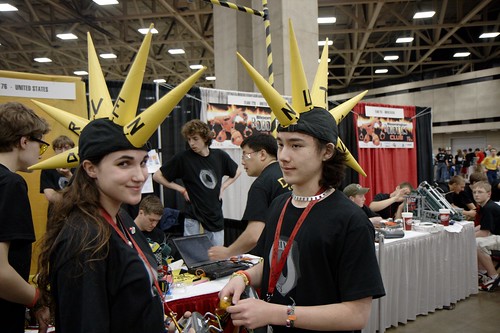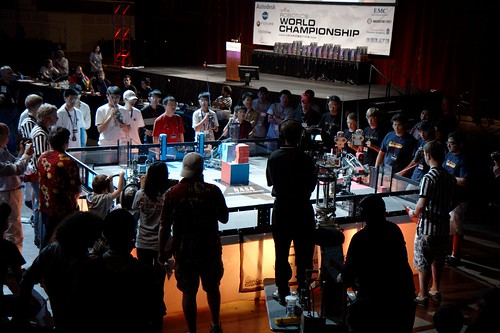It all started when Tom Atwood of Robot Magazine asked me to attend the VEX Robotics World Championship to shoot photos of the more than 270 teams from around the world competing in the event. Before I even knew what happened, I found myself enlisted as one of the judges for the event. Judging the small contests held by local robot groups can be a lot of work but it pales in comparison to the efforts needed for something like the VEX championship. Read on for the full story.
The judging panel itself varied between 10 and 15 indivduals over the
course of the three day event. In addition to the judges, there were
dozens of others acting as referees, score keepers, and doing data entry
to feed information to the judges. At any given moment there were
usually 16 or more teams involved in at least four matches. The scores
only form part of the input for the judging. Several of the judges spent
their entire days in private meetings with each team to evaluate their
engineering notebooks and robots. Other judges, including myself, spent
their days wandering through the pit area, talking to members of each
team, asking questions about their robot, team structure, engineering
approach, and other questions.
By the time a team was recommend for an award, they had often been interviewed by multiple groups of judges several times. Even so, I had my doubts going in that this subjective approach could really pick the best candidates. My doubts were dispelled as the scores from the matches began rolling and we frequently saw the same teams who stood out in the subject analysis of the pit judges climbing in the competition scores as well. What this meant to me is that the teams with good communications, well defined engineering strategies, and good ideas also tended to build winning robots.
But enough about the judging, what was the VEX Championship like? Blue hair and pirate costumes seemed to be the most popular fashions among teams. But there were also plenty of mohawks, fauxhawks, and colorful regional garb from around the world. I was pleasantly surprised to see so many girls on the teams. Engineering and robotics is no longer a male-only field.
Each match consists of four teams playing in pairs. Two blue teams work together against two red teams. The robot must acquire red or blue foam blocks and deposit them in one of three types of containers to gain points. Unlike many high-school level events, the VEX contest is not just another remote-control vehicle contest. While the majority of each match is spent with the robots in teleoperated mode, the contest emphasizes autonomy as a goal of building robots. The robots must operate autonomously for a portion of time at the beginning each match. Robots that are capable of scoring autonomously give the teams a much better chance of winning. There is also a college level contest in which only autonomous action is allowed but the vast majority of time is spent with the middle and high school level matches.
The first day of the event is spent in practice and preparation. Each team must have their robot inspected by officials to verify that it meets the rules. Teams then spend most of their time running the robots on the test fields in test matches as they fine tune the operation and work out bugs. The next two days are spent in elimination matches and eventually playoffs to find the winners. There are also various breaks in the matches to present awards.
If you like to see more of the event, don’t worry, I shot more photos that you could possibly ever want and posted about half of them on flickr, so go ahead and have a look at the VEX Robotics World Championship photo gallery.






